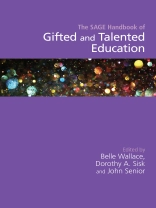The SAGE Handbook of Gifted & Talented Education provides a comprehensive and international overview of key challenges and issues in the field of gifted education, making this an invaluable volume for individuals in the fields of education, public and private school administration, psychology and beyond.
Containing contributions by a range of expert authors from around the world, chapters include discussions of the wide range of human abilities and talents which impinge upon academic success, with explorations of various political, social and economic factors which influence how ‘giftedness’ and ‘gifted education’ is defined and understood in different regions around the globe.
PART 1. CONCEPTS OF GIFTEDNESS AND IDENTIFICATION: SOCIAL AND EMOTIONAL NEEDS
PART 2: EDUCATIONAL PROVISION: PROGRAMS AND STRATEGIES
PART 3: GLOBAL RESPONSES TO EMERGING G&T PROVISION: DEFINING THE FUTURE
Table of Content
Preface – Chris YappGeneral Introduction to the Handbook – Belle Wallace, Dorothy A. Sisk, and John Senior
SECTION 1: Concepts of Giftedness and Identification: Social and Emotional Needs
Introduction to Section 1 – Dorothy A. Sisk
Chapter 1: Is Gifted Education on the Right Path? – Robert J. Sternberg
Chapter 2: Spiritual Intelligence: Developing Higher Consciousness – Dorothy A. Sisk
Chapter 3: Exchanging Giftedness for a Better Gift – Janet E. Davidson
Chapter 4: Tapping the Untapped – Untold Stories: Revisiting the Concept of Giftedness through the Mirror of Multi-Cultural India – Krishna Maitra and Yukti Sharma
Chapter 5: Honoring Differences: Improving the Representation of Culturally Different Gifted Students based on Equity – Donna Y. Ford, Ramon B. Goings, Jemimah L. Young, and Brian L. Wright
Chapter 6: Creativity and Genius – Dean Keith Simonton
Chapter 7: Why Bother Being Different? The Role of Intrinsic Motivation in Creativity – Kelsey Procter Finley and Mihaly Csikszentmihalyi
Chapter 8: New Dynamic Approach to Measure Creativity: Implications for Indentification and Education – Taisir Subhi Yamin
Chapter 9: Profoundly Gifted: Outliers among the Outliers – Stephanie Tolan
Chapter 10: Eminence in Talented Women by Domain: Issues, Similarities, and Differences Utilizing the Piirto Pyramid as a Theoretical Framework – Jane Piirto
Chapter 11: Accepting Exceptionality: Giftedness and ADHD – Kelly M. Lee and F. Richard Olenchak
Chapter 12: Hidden Treasures: Twice Exceptional Students – Linda Kreger Silverman
Chapter 13: Serving and Honoring Gender Diversity in Education – Robert W. Seney
Chapter 14: The Emotional Development of the Gifted and Talented – Joan Freeman
Chapter 15: Friendships of Gifted Children and Youth: Updated Insights and Understanding – Bruce M. Shore, Tanya Chichekian, Petra D.T. Gyles, and Cheryl L. Walker
Chapter 16: Parental Influence on Perfectionism among Chinese Gifted Children in Hong Kong – Lai-kwan Chan
SECTION 2: Educational Provision: Programs and Strategies
Introduction to Section 2 – Belle Wallace
Chapter 17: Building Knowledge Bridges: Synthesising early years and gifted education research and practice to provide an optimal start for young gifted children – Margaret Sutherland and Niamh Stack
Chapter 18: Engineering the Schoolwide Enrichment Model: A Case Study of the Process of Change in Education – Joseph S. Renzulli and Sally M. Reis
Chapter 19: TASC: Thinking Actively in a Social Context: a universal Framework for Developing Thinking Skills and Problem-solving Across the Curriculum – Belle Wallace and Harvey B. Adams
Chapter 20: Real Engagement in Active Problem Solving: An International Collaboration – C. June Maker and Randy Pease
Chapter 21: Designing Dynamic Learning Spaces for Gifted Learners: Authentic, Augmented and Actualized Places and Placements – Gillian Eriksson
Chapter 22: How to Create and Sustain a Culture of Excellence that benefits Highly Able Students to enter Top Research Universities – Ian Warwick
Chapter 23: Meta-analysis of 26 Forms of Academic Acceleration: Options for Elementary (Primary) and Secondary Learners with Gifts or Talents – Karen B. Rogers
Chapter 24: What works better than the rest? The impact of various curricula provisions for gifted learners – Janna Wardman and John Hattie
Chapter 25: Continuum of Differentiation – Sandra N. Kaplan
Chapter 26: The National Mentoring program in Israel: A model for developing leadership among highly gifted students – Rachel Zorman, Menachem Nadler, Pnina Zeltser, and Zipi Bashan
Chapter 27: Capacities, Challenges, and Curriculum for Australian learners with exceptional potential for English-language learning – Aranzazu M. Blackburn and Susen R. Smith
Chapter 28: Career-life counselling for the gifted in sub-Saharan Africa – Jacobus G. Maree
Chapter 29: Recognizing, Developing and Offering Talents as Educational Gifts through Living Theory Research – Jack Whitehead and Marie Huxtable
Section 3: Global Responses to Emerging G&T Provision: Defining the Future
Introduction to Section 3 – John Senior
Chapter 30: The Education of Highly Able Children in England: Challenges and Achievements – Hilary Lowe
Chapter 31: Creativity Competition for Gifted Students′ Communication and Self-Esteem Development – Finarya Legoh
Chapter 32: Gifted Education in Brazil: Historical Background, Current Practices and Research Trends – Eunice M.L. Soriano de Alencar, Denise de Souza Fleith, and Liliane Bernades Carneiro
Chapter 33: New Century Gifted Education in Mainland China – Jiannong Shi and Pin Li
Chapter 34: Gifted Education in Asia: Vision and Capacity – David Yun Dai
Chapter 35: Developments and Issues of Gifted Education in Taiwan – Ching-Chih Kuo
Chapter 36: Development of Gifted Education in Turkey – Ugur Sak, Bahadir Ayas, Bilge Bal-Sezerel, N. Nazli Özdemir, Ercan Öpengin & Sule Demirel
Chapter 37: Gifted Education in Europe – Andrzej E. Sekowski, Barbara Cichy-Jasiocha, Martyna Pludowska
Chapter 38: Giftedness in a Context of 21st-Century Globalization – Don Ambrose
Chapter 39: The creative being and being creative: human machine neural networks – Eva Gyarmathy
Chapter 40: Gifted Education: The Future Awaits – Ken Mc Cluskey
Conclusion – Belle Wallace, Dorothy A. Sisk, and John Senior












